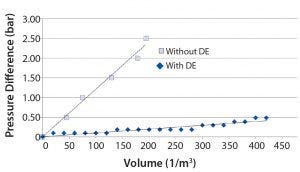- Sponsored Content
Increased Clarification Capacity: Using Filter Aid and FILTRODISC™ BIO SD for an Economical FiltrationIncreased Clarification Capacity: Using Filter Aid and FILTRODISC™ BIO SD for an Economical Filtration
Sponsored by Filtrox
 Clarification of fermentation broths is one of the most important steps in bioprocessing. The first purification step after fermentation is the cell harvest, which is designed to remove cells and cell debris as well as to reach maximum product yield in compliance with existing regulatory environments. Standard technologies (centrifugation, separators, membrane, and depth filtration) can no longer handle the high particle loads (>108 cells/mL) in an economical way.
Clarification of fermentation broths is one of the most important steps in bioprocessing. The first purification step after fermentation is the cell harvest, which is designed to remove cells and cell debris as well as to reach maximum product yield in compliance with existing regulatory environments. Standard technologies (centrifugation, separators, membrane, and depth filtration) can no longer handle the high particle loads (>108 cells/mL) in an economical way.
Deciding on the right purification system involves addressing questions about process performance, economics, and existing regulatory requirements. Process performance challenges include higher and higher cell titers, cell debris content, scalability, and flexibility for process changes and future processes, higher product yields, and constant high-quality product flow for further downstream purification.
Alluvial filtration (see box below) is a well-established and economical method in pharmaceutical industries (plasma fractionation). Use of a filter aid such as diatomaceous earth (DE) provides a large capacity for high particle loads, which corresponds to dramatically extended filtration volumes per filter area (up to 80%).
Alluvial Filtration |
|---|
Alluvial filtration is a type of depth filtration. Instead of using an immobilized depth-filter medium, a filter aid (e.g., diatomaceous earth or perlite) is used to constantly build a filter cake during filtration. The filter cake with its resistance then acts as the actual filter medium. Alluvial filtration, therefore, leads to a higher filter capacity, especially with compressible particles (e.g., microbial or mammalian cells). Below figures show principle of standard depth filtration (left) and alluvial filtration (right). |

Figure 1: Filtration capacity with and without filter aid
FILTRODISC™ BIO SD is the first depth-filter system using the advantages of combining standard depth filtration with alluvial filtration in a disposable format. Filtration optimization and scale-up are easy to perform. It is not necessary to add flocculants nor to change the pH.
Due to the efficiency of the FILTRODISC™ BIO SD system, a single step is sufficient to separate cells, microorganisms, and cell debris from the fermentation broth/homogenate and to remove host-cell protein (HCP) and DNA at the same time.
The small footprint of the system allows using it in small production facilities. It eliminates the centrifuge and combines the first two steps in cell harvest: centrifugation and depth filtration.
Corinne Luechinger is head of FILTROX Academy, and Ralph Daumke is market manager of biologics at FILTROX AG, Moosmuehlestrasse 6, 9001 St. Gallen, Switzerland, www.filtrox.com, [email protected]; [email protected].
You May Also Like






